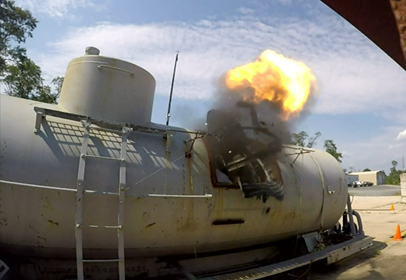
Each day, more than twenty-six thousand commercial flights transport passengers and cargo to destinations around the world. Several U.S. government agencies work together to secure these flights, including the Department of Homeland Security (DHS) Science and Technology Directorate (S&T). S&T’s Commercial Aircraft Vulnerability and Mitigation (CAVM) program, part of the Homeland Security Advanced Research Projects Agency Explosives Division, supports testing and evaluation efforts to assess potential vulnerabilities and evaluate countermeasures that can mitigate the impact of explosives on commercial aircraft. Recently, CAVM partnered with the Federal Aviation Administration (FAA) and U.S. Army Aberdeen Test Center (ATC) to develop a reusable Aircraft Explosive Testing Simulator that facilitates the explosive testing of new generation commercial aircraft.
The majority of current commercial aircraft have aluminum fuselages, and CAVM has conducted a significant amount of explosive vulnerability testing on a wide range of those aircraft types. However, newer generations of commercial aircraft fuselages are being made with composite materials, such as carbon fiber reinforced plastic. Understanding the potential vulnerability of composite aircraft to explosives requires testing, but the new generation composite aircraft fuselages are less available and more expensive than legacy aluminum fuselage structures. This made it essential to develop a sustainable and representative testing solution so evaluations of new composite aircraft structures to explosive-based threats could continue as needed.

“The lack of availability of new generation composite commercial aircraft structures for use in destructive explosive testing necessitated development of alternate test methods and tools,” said Nelson Carey, CAVM Program Manager. “Doing so is essential to provide S&T and its U.S. government customers with accurate and efficient methods for conducting commercial aircraft explosive vulnerability assessments.”
Based on this need, ATC developed the Aircraft Explosive Testing Simulator that could be used for repeated explosive testing. The simulator consists of a steel cylinder that can be pressurized to simulate conditions of an in-flight aircraft. The cylinder has an opening where composite test panels are installed and subjected to testing for a variety of explosive threat scenarios. The composite aircraft test panels are provided through an interagency agreement with the FAA and the National Institute for Aviation Research, an FAA Center of Excellence.
“Interagency cooperation in support of CAVM efforts is essential for extending limited resources and insuring a maximum rate of return on research and development investment,” Carey said.

During a test, evaluators place an explosive threat inside the simulator, which is then pressurized to simulate airline operational flight profiles. Once the explosive is detonated, instrumentation gathers data on internal and external pressure resulting from the blast, and high speed video instruments gather information on the panel’s physical condition, looking for any deformation, breach, or crack growth. Aircraft vulnerability experts from S&T’s Transportation Security Laboratory then conduct a post-blast inspection and analysis to determine the structural response of the composite test panel to the specific explosive threat condition. Finally, evaluators remove the panel from the simulator and install a new one in its place, allowing for multiple tests to be conducted within a short time period.
“The Aircraft Explosive Testing Simulator provides a rapid, reconfigurable and cost effective tool for acquiring test data on composite aircraft structural response to internal explosive threats,” Carey explains, highlighting the impact the tool has on testing efforts.
Not only does the Aircraft Explosive Testing Simulator help S&T develop a better understanding of how explosives affect composite commercial aircraft, it also allows experts to compare results with previous tests on aluminum structures. CAVM researchers will use the data to learn about composite-based commercial aircraft structure vulnerability to terrorist-based internal explosive threats. This research supports the Transportation Security Administration’s sponsor requirements to investigate the vulnerability of new generation composite construction commercial aircraft to internal explosive threats.
S&T is already sharing its findings from the simulator with other government partners. The Department of Defense’s (DoD) U.S. Army Research Laboratory is using the data to develop numerical analysis models and tools to help simulate composite structure response for different and more complex threat scenarios. Additionally, CAVM recently hosted a round of tests with TSA, FAA, DoD, TSL, and the French government’s Alternative Energies and Atomic Energy Commission (CEA). The event was part of an international effort to strengthen aviation security by bringing together officials from around to globe to share findings and discuss shared goals.

